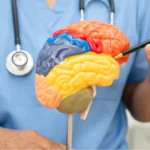Symptoms, diagnosis and treatment
Persistent neck pain is not something that should be normalized. Especially when accompanied by upper limb symptoms, such as weakness or numbness in one arm. These symptoms may be related to cervical protrusion, a fairly common disc disorder affecting the sub-axial spine (lower-middle neck), the most common being C5-C6 protrusion, which is caused by degeneration of the disc between the fifth and sixth cervical vertebrae.
This article discusses in detail what exactly this condition is, how it differs from a herniated disc, what the most common symptoms are, how it is correctly diagnosed, and what treatment options exist – from the most conservative to surgery.

What is a cervical protrusion?
A cervical protrusion occurs when the intervertebral disc, the structure that cushions the contact between two vertebrae, is deformed and protrudes beyond its normal limits, without completely breaking the annulus that contains it.
In the case of a C5-C6 disc protrusion, this alteration occurs between the cervical vertebrae C5 and C6, which play a fundamental role in the support and mobility of the neck.
When this protrusion comes into contact with a nearby nerve root, symptoms such as pain, tingling, muscle weakness or loss of sensation in the neck, shoulder or arm may appear.
Protrusion or herniated disc? Understanding the difference
It is very common to confuse a protrusion with a herniated disc, but they are not the same:
- In disc protrusion, the disc is deformed but the nucleus is not completely protruded.
- In cervical disc herniation, the nucleus pulposus passes through the annulus fibrosus and can directly compress the nerve or even the spinal cord.
In other words, the protrusion is a less advanced stage of the disc degeneration process. Even so, the most important thing is to see the type of neurological compromise that is occurring, which is what will mark the treatment plan, since there are cervical protrusions that come to compromise a nerve root in the same way as a herniated disc.
Most common symptoms of cervical protrusion
Symptomatology may vary depending on the individual, the degree of protrusion and the sensitivity of the nerve structures. However, the most common symptoms include:
Persistent neck pain
It is usually a localized pain in the neck, which may increase with certain movements or maintained postures, such as looking down or spending time in front of screens.
Pain radiating to the arm
If the nerve root is compressed, it is common for pain to radiate from the neck to the shoulder, arm, and even to the fingers.
Muscle weakness
Many patients notice that they lose strength to lift objects, write, or hold the arm in certain positions.
Tingling or numbness
Especially on the outer side of the arm or on the hand.
Dizziness or feeling of instability
In some cases, cervical irritation is also associated with cervical dizziness, which is usually due to the contracture of the cervical musculature and the limitation in the mobility of the head that this generates, which causes the ear (main organ of balance) to manifest itself every time we make a sudden change of posture.
Why does a disc protrusion appear?
The causes may be multiple, but in most cases it is due to a degenerative process of the intervertebral disc. As we age, the disc loses water, elasticity and cushioning capacity. This makes it more susceptible to deformity or displacement.
Other factors that increase risk:
- Maintained postures (work in front of the computer, prolonged driving).
- Repetitive physical stress on the neck.
- Sudden movements or trauma.
- Genetic predisposition.
- Sedentary lifestyle and neck muscle weakness.
Diagnosis: how is cervical protrusion confirmed?
The diagnosis must be clinical and imaging. That is, an MRI is not enough; the physician must correlate the findings with the patient’s symptoms.
1.- Clinical evaluation
It includes tests of strength, sensitivity, reflexes and maneuvers such as the Spurling test, which seeks to reproduce pain when the neck is compressed in certain positions.
2.- Magnetic Resonance Imaging (MRI)
It is the most accurate test to visualize the protrusion, its size and the relationship with the nerve roots. It also allows to assess the general condition of the cervical spine.
3.- Computerized axial tomography (CAT) scan.
Useful to rule out other problems such as cervical arthrosis, instability or to rule out a possible fracture of a vertebral body.
4.- Electromyogram (EMG)
Sometimes, especially when several levels are affected, it is advisable to complete the study with an electromyogram, which is a functional test that identifies the cervical root that may have the greatest degree of involvement and be responsible for the symptomatology.
Treatment for cervical protrusion
The vast majority of patients with cervical protrusion improve without surgery. Initial treatment is usually conservative and is adapted according to the intensity of the symptoms and their evolution.
Conservative treatment
- Specific physiotherapy: exercises to stabilize and strengthen the cervical musculature.
- Anti-inflammatory and analgesic medication: in phases of acute pain.
- Cervical infiltrations: in cases where pain persists despite initial treatment.
Complementary recommendations
- Avoid prolonged use of cell phones.
- Correct posture in front of the computer.
- Sleep with a suitable pillow.
- Practice gentle exercises such as stretching or yoga (supervised).
When is surgery indicated?
Surgery for cervical protrusion is indicated when:
- Pain does not improve after 3-6 months of conservative treatment.
- There is progressive weakness in the arm.
- There is spinal cord involvement (myelopathy).
- Pain is disabling and severely affects quality of life.
The most commonly used technique is microsurgical cervical discectomy with arthrodesis (fusion of the affected segment) or, in some cases, the implantation of a disc prosthesis.
Frequently asked questions about cervical protrusion
Does cervical protrusion always cause pain?
No. Many protrusions are asymptomatic and are detected in studies performed for other reasons.
Can it disappear over time?
In some cases the course of the disease can be halted and symptoms may improve with appropriate treatment.
Can I live a normal life with a cervical protrusion?
Yes, most patients resume their normal life with some postural adaptations and strengthening exercises.
Is it always necessary to operate?
No. Surgery is indicated only if conservative treatment fails or there are progressive neurological signs.
In summary, a cervical protrusion, such as a C5-C6 protrusion, can cause significant discomfort, but in most cases it is a manageable condition without surgery. The approach should always be individualized, combining a good clinical evaluation, diagnostic imaging and a tailored treatment plan.
Detecting symptoms early, adapting lifestyle and relying on a medical team specialized in cervical spine are the keys to an effective and lasting recovery.
If you are looking for neurosurgeon in Malaga, neurosurgeon in Seville or neurosurgeon in Cadiz, Andrés Muñoz, is your doctor.
📍 Dr. Andrés Muñoz – Specialist in neurosurgery and spine surgery
📞 609 688 469



